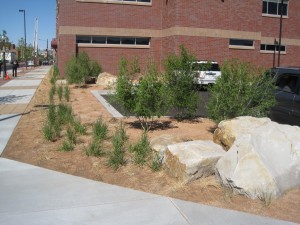
Landscape edging is the physical barrier between two landscape surfaces, most commonly a landscape bed and turfgrass. There is a multitude of types of landscape edging available on the market today, but how much of it is beneficial to your landscape? I am going to discuss the most common types of edging and provide some pros and cons for each:
The Non-Existent Edge: Many years ago, landscapes did not have edging of any sort. There was a softness to the landscape, where planting beds flowed gently into the turfgrass areas. This can be an attractive appearance especially in the more rural landscapes. The drawback to this “edge” is the maintenance of keeping the two landscapes separate. The utilization of turfgrass within an organic mulch or landscape rock bed or vice-versa is not attractive. The positive of this treatment is the invisibility of the landscape edging.
Decorative Landscape Edging: This edging is becoming a common practice among the DIY (Do It Yourself) group of people, especially homeowners. It is the easiest edging to install, because the majority of it is above-grade. It can come in many different forms, shapes, themes, etc. If an ornamental edge is the desire of the owner, this may be the choice. Buyer beware, most of these types of applications do not provide the fundamental aspect of what the edging is to do, which is provide a barrier for the roots to spread. This is not my choice of edging, however, I have seen it pulled off wonderfully in small applications in the past.
Plastic Edging: Plastic Edging is the cheapest of the types of edging (aside from not having an edge at all). It can have its place and I have actually installed it a few times in my landscape contractor days, and for my parent’s landscape. More often than not, plastic edging looks awful in the landscape and the primary reason for that is a bad installation. If plastic edging is not installed correctly, it can come out of the ground very easily. When a piece of it comes out of the ground, it is susceptible to kids assisting it the remainder of the way out. When I installed this type of landscape edging for my parents, I was adamant about how low to the ground it needed to be. I feel that it came out very nicely in hindsight, as the edging is now virtually invisible. The primary purpose for the edging is to prevent the spread of the plants (groundcover or turfgrass) from exiting their defined space.
Steel Edging: Steel Edging is more expensive to install than plastic edging, however the durability of it is drastically better. It can be useful for curves, straight lines and other application giving a cleaner appearance than plastic edging. The installation of the steel edging again is key. When a planting bed is designed to be straight, and it obviously is not, the end result is awful. A reliable contractor is crucial to the final appearance. Steel edging lends itself to be invisible in the landscape better than plastic edging. The top of the edging is very narrow and easily hidden, but a poor installation could ruin this as well.
Concrete Edging: Concrete edging is by far the most durable and reliable of the edging types. It has a bold appearance and can add a lot to the landscape, whereas the other edging types are best if they are hidden. Many varieties of concrete edging are available with the multitude of colors, shapes, forms and designs that can be utilized. The negative in utilizing concrete edging is the price. It can add to the cost of the landscape very quickly.
Brick or Stone Edging: Utilizing hand-set bricks can add the charm to the landscape. There are many ways to set the bricks in many interesting ways that should be left to the owner for preference. Some ways can be more cost-effective than others. The negative of this application is again the costs associated with the labor and materials of brick.
I am going to provide a follow-up post to this one and I will discuss where in the landscape each of these types are appropriate and when they are not. Stay tuned…





1 thought on “Landscape Edging: Which Variety Should I Use?”
This is a great article on landscape edging. You really summed it up. When it comes to selecting edging materials, there are several things to consider: the overall look you are trying to achieve, material costs, installation time, and maintenance issues, such as mowing. The company I work for, McGraw-Hill, can help you decide. They have a list of top manufacturers and suppliers to start with. You can even download CAD details from their site. Check it out.